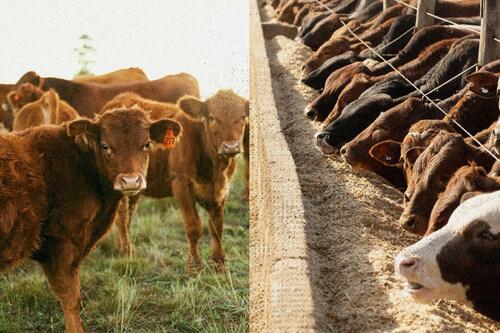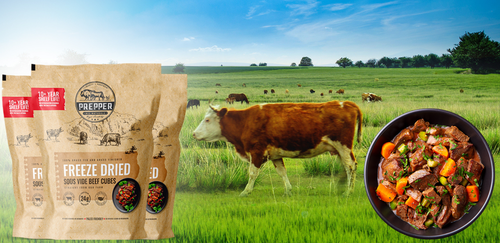
Grain-Fed Vs. Grass-Fed Beef: What’s the Difference?
Authored by Emma Suttie, D.Ac via The Epoch Times,
How many of us truly know the difference between grass- and grain-fed beef beyond its impact on our wallets?
 Clint Austin/PeopleImages.com – Yuri A/Shutterstock
Clint Austin/PeopleImages.com – Yuri A/ShutterstockHow cattle are fed and raised affects their meat’s flavor, texture, and nutritional value—while also impacting the environment and the costs for both farmers and consumers. Understanding what goes into the beef we eat is key to making more informed choices.
Let’s explore the differences and see which option might be best for you, the planet, and the animals.
Early Life
Raising cattle is a complex process, and they go through different stages before they reach our plates.
Cattle destined to become either grain- or grass-fed start their lives in a similar way. As calves, they nurse from their mothers and roam freely, grazing on grass and other plants or forage. However, once they are weaned, their paths diverge, and their lives are very different.
Grain Fed Cattle
After the initial stage, when animals are usually between 6 and 8 months old, conventionally raised cattle may be moved to backgrounder farms and ranches before they arrive at a feedlot for finishing at about 14 to 22 months.
Allison Kosto, a Broadwater County Extension Agent at Montana State University Extension, said that after calves are weaned, they have a couple of potential destinations.
Around 60 percent of calves are backgrounded—a phase designed to increase their weight before finishing. The remaining calves go to a feedlot for finishing directly after weaning, she told The Epoch Times in an email.
Feedlots are where cattle are finished—or fattened up—on a grain-based diet that usually contains corn and soy. This diet brings the animals to their target weight more quickly, preparing them for slaughter sooner.
“About 95% of cattle in the United States are finished this way,” Kosto said. “The reason behind this practice is that as cattle become older, they become less efficient, making it more difficult for them to convert feed to muscle or meat,” she said.
Kosto added that grain provides more energy than forage, such as grass or hay, so the cattle grow faster. In addition, feeding grain enables cattle to be kept in smaller spaces, freeing up land farmers can use for other purposes.
Feedlots, feed yards, or concentrated animal feeding operations (CAFOs) are large operations with animals in more confined spaces. Although this option is more economical, crowded conditions can expose animals to potential health problems because of their close quarters and limited ability to move.
However, Kosto says one of the biggest misconceptions about the difference between grain and grass-fed beef is that grain-fed animals spend most of their lives in confinement, which she says isn’t true. Conventionally raised animals typically spend only their last four to six months eating grains in feedlots.
“Grain-fed cattle are typically slaughtered between 14–18 months of age, but could be up to 22 months of age,” Kosto noted. Grass-fed cattle take much longer to finish, are typically slaughtered between 22 to 30 months of age, and are less likely to go through a backgrounding phase, she added.
Conventionally raised cattle receive various medications, such as vaccines for respiratory and gastrointestinal diseases; antibiotics to prevent and treat infection; steroid implants to promote growth; and anabolic compounds to encourage weight gain and feed efficiency. Antibiotics, like tetracycline and sulfamethazine, deworming, and parasite treatments, are given preventatively to combat the stress the animals may experience from transport and crowded conditions.
Stress affects the animals, as well as the finished product.
“Animals that have been stressed release hormones into the meat, which results in it being less tender. In general, grass fed beef has been exposed to fewer stress events in their life than traditional grain-finished cattle,” Kosto said. “However, just because animals are grain-fed does not automatically mean they were stressed. Stress is related to lots of factors such as animal handling, management, and transportation before slaughter,” she added.
There are also concerns that increasing antibiotic use in cattle, particularly in large-scale feedlot operations, contributes to multidrug antibiotic resistance. Such resistance makes it increasingly difficult to treat infections with conventional medicine.
A recent study by researchers at the University of Saskatchewan found an antibiotic-resistant gene in cattle feedlot water bowls, and another recent study states that antibiotic use in farming is expected to increase by 8 percent in the decade between 2020 and 2030.
Grass-Fed Cattle
After weaning, grass-fed cows graze in open pastures, eating grass and other forage. They can move around freely and spend their days outdoors. These cows tend to be healthier because they live harmoniously with their environment and eat their natural diet. Grass-fed cattle make up approximately 4 percent of beef in the United States.
Because grass has less energy and fewer calories, grass-fed animals take longer to reach their target weight (up to twice as long). They also require more land for grazing than their grain-fed counterparts, making operations more expensive.
Cattle that have eaten grass their entire lives have leaner meat with less fat.
When we see grass-fed beef on grocery store labels, we assume these animals ate grass their entire lives and never ate grain. However, there is some ambiguity in grass-fed claims.
Tom Moore raises 100 percent grass-fed beef on his cattle farm, M & M Farms, in Arkansas.
“Well, if you say 100 percent grass-fed, that pretty much covers it. But, if you just call your cattle or your product grass-fed, that leaves room for the fact that, yes, it ate grass once in its lifetime—however, for the last several months of its life, it could have been fed a heavy diet of grains,” he said.
 Click to buy grass-fed / grain-finished, amazing freeze-dried beef. We’ve tried it, we love it, we will defend it from marauders in the apocalypse…
Click to buy grass-fed / grain-finished, amazing freeze-dried beef. We’ve tried it, we love it, we will defend it from marauders in the apocalypse…“Very often, they [cattle] would go right from milk to grain in a commercial pipeline, and they probably have enough grass that they could legitimately say that they had been fed grass—but you almost cannot prevent them from eating grass—that’s their food of choice,” he added.
Grass Finished
There is also beef labeled grass-finished. Kosto says that although this term is sometimes used interchangeably with grass-fed, these terms can have different meanings.
“Grass-finished means the animal was brought to finish weight on a non-grain, forage-based diet,” she said.
“By definition, it is possible for grass-finished beef to be fed grain at some point in its life. However, during the final finishing phase, the animal was still brought to its final weight on a grass/forage based diet,” she added.
Because there aren’t label guidelines for the term grass-finished, Kosto said that producers can still use it for animals who have eaten grass their entire lives.
Health Comparisons
Kosto says that grass-fed animals are generally leaner and have less fat and fewer calories. Studies show that grass-fed meat has higher vitamins A and E, omega-3 fatty acids, and conjugated linoleic acids.
Both grass and grain-fed beef are high in a wide variety of nutrients. However, studies show that grass-fed beef is higher in many beneficial nutrients, improving the animal’s health—and ours when we eat them.
Andrea Soares, a registered dietitian with Top Nutrition Coaching, spoke to The Epoch Times about the difference between grass- and grain-fed beef. She said grass-fed beef has become popular for its potential health and environmental advantages, as it provides a more natural and nutrient-dense alternative to grain-fed beef. Since grass is a part of the animal’s natural diet, she said this approach may promote better health for the animals and those who consume the meat.
“While grass-fed beef tends to be leaner and richer in certain nutrients, grain-fed beef is often preferred for its affordability, tenderness, and milder flavor due to higher fat content. Both can have a place in a healthy diet, but grass-fed beef may offer added advantages for those seeking specific health benefits,” she said in an email.
“Grass-fed beef contains up to five times more omega-3 fatty acids than grain-fed beef. Omega-3s are crucial for reducing inflammation, supporting cardiovascular health, and improving brain function,” Soares said.
She added that grain-fed beef contains higher levels of omega-6 fatty acids. Although omega-6s are essential, they tend to be overly abundant in the modern diet, which may contribute to inflammation if not balanced with omega-3s. Grass-fed beef provides a healthier balance of omega-3 to omega-6 fatty acids, she said.
Too many omega-6 fatty acids and too few omega-3s make us more prone to inflammation, make the immune system more reactive, and increase the likelihood of blood clots.
Grass-fed beef is higher in B vitamins. One study found that grass-finished beef had almost twice the riboflavin, three times the thiamine, and as much as four times the vitamin E of beef finished on grain.
Another study found that the longer bulls were on a high-concentrate corn diet, the more insulin resistant they became, and their average daily weight gain and feed efficiency, or ability to turn food into energy and body mass, decreased. The study also suggests inflammation could be a factor in developing insulin resistance in cattle.
Pesticides
Grains like corn and soy are subsidized by the government, making it a more economical option for farmers. However, grains grown for livestock are sprayed with pesticides like glyphosate (the active ingredient in Roundup) to increase yields. Although the U.S. Environmental Protection Agency (EPA) has guidelines for maximum residue limits for glyphosate in food, including animal feed, The International Agency for Research on Cancer has classified glyphosate as a probable human carcinogen (Group 2A), and recent research found that even brief exposure in mice led to significant inflammation in the brain which is associated with neurodegenerative diseases like Alzheimer’s. The study also found that the effects persisted even after exposure.
Soares said that grass-fed animals are less likely to encounter pesticides because their diet mainly consists of grass and forage, steering clear of conventionally grown crops like corn and soy, commonly used in grain-fed diets. By contrast, grain-fed cattle often consume feed that may carry pesticide residues from treated crops, she added.
Soares noted that although regulatory agencies monitor and maintain pesticide levels in grain-fed beef within safe limits, minimizing exposure is especially important for people with increased sensitivities or those striving for a cleaner food option.
And then there are the environmental implications.
“Grass-fed systems often rely less on pesticide-intensive agricultural practices, promoting biodiversity and soil health. This may resonate with consumers prioritizing sustainability,” she said.
Pesticides used on crops fed to livestock can also leave residues that accumulate in the animal’s fatty tissue, which can be passed on to consumers in the final product. Although regulatory agencies like the EPA set maximum limits for pesticides in foods, the long-term health implications of low-level pesticide exposure through meat consumption are still being studied.
Regulatory bodies ensure that food safety standards are met—however, there are concerns that long-term exposure and its cumulative effects may have long-term consequences for human health. More research is needed to fully understand the health effects of consuming pesticide residues in beef and other animal products.
One way to avoid these chemicals is to choose organic products—a U.S. Department of Agriculture (USDA) certification used in grass and grain-fed beef. These animals are raised without antibiotics and growth hormones and eat forage and grain not treated with pesticides.
Labeling and Grading
The Food Safety Inspection Service (FSIS), which is part of the USDA, has updated its rules about labels on meat and poultry products. These labels can include terms like “Grass Fed,” “Raised Without Antibiotics,” “Free-Range,” or “Raised Without the Use of Hormones.”
These labels—called “special statements and claims”—are optional. Farms and companies can choose to put them on their products, but they aren’t required to do so.
For now, the FSIS has decided not to create official definitions for animal-raising claims in its rules.
The FSIS also recommends beef producers use independent third-party organizations to verify animal-raising claims, such as “grass-fed” or “hormone-free.” If a product has a third-party certifier’s name, logo, and website on the label, it doesn’t need to explain the claim on the product itself as long as the certifier’s website clearly explains the claim and the standards behind it.
Moore’s farm works with a third-party inspector called A Greener World, which gives his farm an “animal welfare” and “100 percent grass-fed” certification. His was the first farm in Arkansas to receive the certifications.
Moore says that to receive animal welfare certification, an inspector comes to the farm and examines different aspects, like the animals’ feed and water sources, and ensures they have adequate shelter in case of extremely cold weather or if their pasture is destroyed by fire. There are also strict rules about what medications can be given, and he must keep meticulous records of the medications animals receive.
“They’ll even go as far as look at the trailer that we transport our animals in and make sure we’ve got a non-skid surface in the trailer so that if we’re going down the highway, the animals have less chance of slipping and being hurt,” Moore said.
“That’s the animal welfare portion of it. That is one label that we’re allowed to use on our packaged product. We also qualify for 100 percent grass-fed, and they monitor that, too,” he added.
Kosto says that the USDA used to have a “USDA-Grass fed Beef” certification program that outlined the requirements for producers to use the grass-fed label, but that it was discontinued in 2016. However, FSIS—part of the USDA—now provides guidelines for using the grass-fed label.
“FSIS states that grass fed claims may only be applied to meat and meat products derived from cattle that were only (100%) fed grass (forage) after being weaned from their mother’s milk. FSIS does not provide any guidelines for ‘grass-finished,’” she said.
Kosto also noted that while FSIS requires documentation to support grass-fed claims, it doesn’t provide a certification program like the previous one offered by the USDA, adding that an example would be the USDA-Certified Organic certification program, which requires extensive documentation and inspections to support label claims.
There are downsides to raising grass-fed cattle, noted Kosto.
“Because a grass-fed animal requires more time on feed to reach a target weight, the meat has less marbling [fat] and is less likely to grade prime,” Kosto said.
The USDA has a system for grading beef, which indicates its quality, fat content (or marbling), tenderness, juiciness, and flavor. Three grades are sold at the retail level: “Prime” is the highest quality, followed by “Choice” and “Select.” Grading is voluntary, and meat processing operations must pay for the service. The USDA notes that protein, vitamin, and mineral content are similar regardless of the grade.
Cost Differences
Moore explains the cost difference for him.
“One reason that our product—the 100 percent grass-fed—is more expensive per pound than the factory is that we don’t have the same economies of scale. We can’t turn our cattle around in 18 months—it takes almost twice as long.”
Kosto says another concern is that more land is required to finish animals on a forage-based diet and that the United States is likely at or close to capacity for grass-finished animals. Through subdivision development, productive agricultural land disappears and will never be replaced.
“We are seeing that a lot here in Montana. Additionally, as the population continues to grow, so does the demand for food. Therefore, agriculture in the United States needs to figure out how to be more productive with less land. Quite a conundrum, isn’t it?!” she said.
Final Thoughts
Raising cattle is a complex process, and there’s no simple way to describe all grass-fed or grain-fed animals because many factors come into play. However, all beef is nutritious and provides important protein, vitamins, and minerals. Whether you choose grain-fed or grass-fed beef depends on what’s important to you and what you can afford.
With so many variables, Kosto suggests developing a relationship with agriculture producers and farmers to better understand the industry’s practices—grain-fed or grass-fed—as there are many misconceptions. Your local university extension office can help connect you with local producers.
“Many farmers and ranchers are more than happy to share their world and answer questions. And when you can buy meat directly from them, you are supporting them directly rather than a production chain,” she said.
Tyler Durden
Fri, 01/10/2025 – 18:25


















